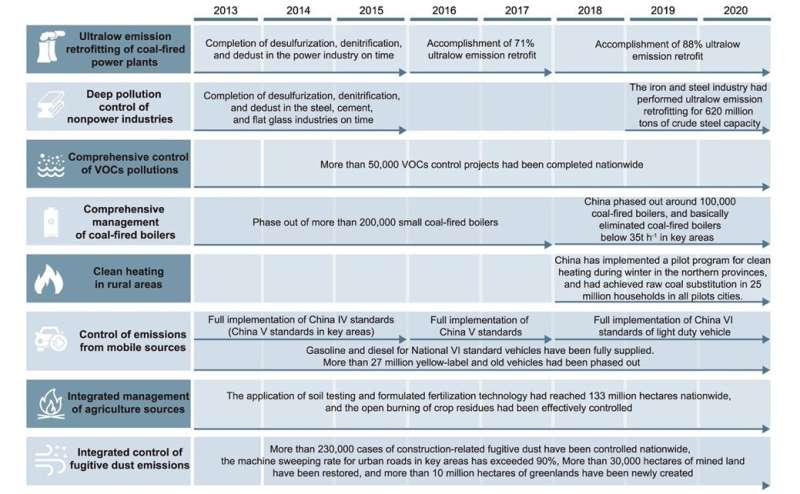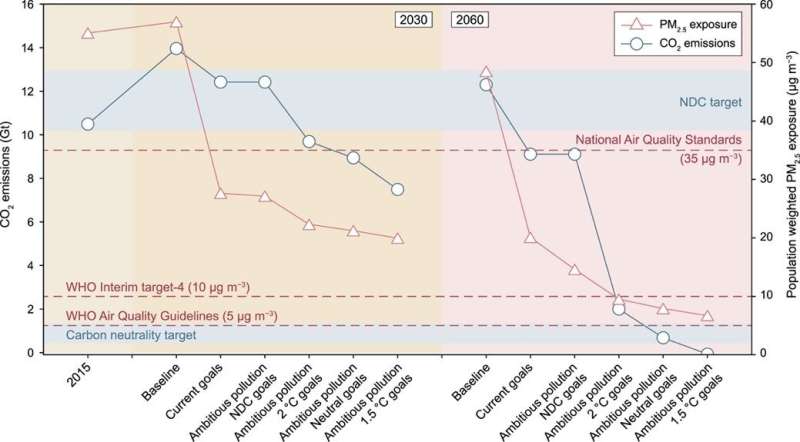This article has been reviewed according to Science X's editorial process and policies. Editors have highlighted the following attributes while ensuring the content's credibility:
fact-checked
proofread
Scientists advocate synergistic approach to address climate change and air pollution in China

In a new research perspective published in Environmental Science and Ecotechnology, a research team emphasizes that the key to a synergistic approach lies in understanding that carbon dioxide and air pollutants predominantly originate from the same sources, namely, the combustion and use of fossil fuels.
Therefore, policies designed to mitigate climate change and control air pollution can generate considerable synergies. In particular, as China has committed to peaking its CO2 emissions by 2030 and achieving carbon neutrality by 2060, the team believes that these goals can serve as powerful drivers for future air quality improvement.
To facilitate the tracking and analysis of the synergistic governance of air pollution and climate change, the researchers developed a suite of 18 indicators. These indicators span five critical areas: air pollution and associated weather-climate conditions; progress in structural transition; sources, sinks, and mitigation pathway of atmospheric composition; health impacts and benefits of coordinated control; and synergistic governance system and practices.
One of the key insights from the research perspective is the recognition of the intricate links between climate change and air pollution. Changes in meteorological factors induced by climate change can significantly impact the formation, accumulation, and dispersion of air pollution. Simultaneously, these changes can affect emissions from natural sources like vegetation, dust, and wildfires, which significantly contribute to air pollution.

In terms of public health, both climate change and air pollution pose substantial risks. Increased frequency of extreme weather events, higher risk of infectious diseases, and exposure to air pollutants can all lead to increased mortality and morbidity. Recognizing this, the researchers argue that public health protection should serve as the starting point for coordinated governance.
The researchers further underline the importance of aligning the control measures for greenhouse gases and air pollutants, given their shared sources and processes. Strategies that target the reduction of fossil fuel consumption and carbon emissions will inherently mitigate air pollutant emissions, offering synergistic benefits for air quality improvement. However, the team also cautions that future carbon sink changes should be factored into planning carbon reduction pathways to avoid compromising air quality.
The research perspective also identifies considerable health and economic benefits that can arise from a synergistic approach to addressing climate change and air pollution. These include reducing the incidence of extreme weather events, saving pollution control costs, improving the structure of the economy, promoting new industries, and creating jobs.
In terms of governance, the researchers advocate for a system that coordinates climate change mitigation and air pollution control, integrating strategic planning, laws, regulations, standards, and economic policies. They recommend piloting this approach in select cities and industries to gain practical experience before a broader implementation.
The research team's ultimate goal is to establish a theoretical framework for the synergetic governance of carbon neutrality and clean air, identify potential challenges in developing a synergetic roadmap for China, and provide corresponding policy recommendations. This comprehensive, synergistic approach could be a game-changer in China's ongoing battles against air pollution and climate change.
More information: Qiang Zhang et al, Synergetic roadmap of carbon neutrality and clean air for China, Environmental Science and Ecotechnology (2023). DOI: 10.1016/j.ese.2023.100280
Provided by Chinese Society for Environmental Sciences





















